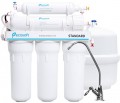Add to comparison |  |  |
|---|---|---|
| Ecosoft Standard MO 550 ECO STD | Ecosoft MO R 6-50 | |
| Outdated Product | from $160.40 up to $255.96 | |
| User reviews | ||
| TOP sellers | ||
| Type | kitchen sink | kitchen sink |
| Reverse osmosis | ||
| Purpose | for cold water | for cold water |
Cleaning specs | ||
| Stages of purification | 5 | 6 |
| Pollution clipping | 0.01 µm | 0.01 µm |
| Filtration speed | 0.13 L/min | 0.13 L/min |
| Types of filtration | mechanical impurities organic impurities softening (scale) chlorine ferrous heavy metals pesticides nitrates cadmium petroleum products | mechanical impurities organic impurities softening (scale) chlorine ferrous heavy metals pesticides nitrates cadmium petroleum products |
| Water mineralization | ||
Connection and cartridges | ||
| Fitting size | ½" | ½" |
| Min. operating pressure | 3 atm | 3 atm |
| Max. operating pressure | 6 atm | 6 atm |
| Max operating temperature | 30 °C | 30 °C |
| Cartridge size | 10SL (10"x2.5") | 10SL (10"x2.5") |
More features | ||
| Tank volume | 12 L | 12 L |
| Tap | ||
| Dimensions | 35x45x15 cm | |
| Added to E-Catalog | may 2018 | september 2013 |